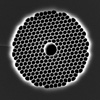While the gear that lights fiberoptic cables continues to evolve rapidly, the changes to fiberoptic cables themselves have been much more incremental for a long time now. That could be on the cusp of changing, as researchers have apparently taken taken the glass out of the equation for some major bandwidth.

In fiber, light travels at 2/3 of the speed of light in a vacuum, while mere air is much less of an obstacle. So what they’ve done at the University of Southampton, as reported in Nature and summarized in this ArsTechnica piece, is to create ‘hollow-core photonic-bandgap fiber’ — basically a hollow tube with microstructured glass all around keeping the photons from straying out of the channel. Without the glass getting in the way that pesky latency goes down by some 30%, which would rock the foundations of the HFT networking vertical again…
Although glass-free fiberoptic cable seems kind of like a cheeseburger without the burger, it has been the focus of a fair amount of research in the past few years. That senator who once described the internet as a series of pipes could have simply been ahead of his time, rather than behind it…
These researchers weren’t working with minor amounts of traffic either. They used 37 streams of 40Gbps for a total of 1.48Tbps at latency levels previously only attainable by microwave at much lower throughput. Of course, it’s not ready for prime time yet. They’ll have to reduce surface scattering loss from 3.5 down to sub-0.2db/km to make it feasible for intercity distances, and then there’s the cost of course.
But if they’re successful in solving the technical problems and can do it economically, then all of a sudden there’s a brand new rationale for new intercity and subsea fiber. All those empty conduits that CenturyLink and Level 3 are sitting on would suddenly come into play, for instance, and those fiber IRUs from the bubble days would be less able to keep up.
Even if they have trouble getting the loss down that low, there could be significant applications in short range applications. The cloud could suddenly get a whole lot more dense in latency terms.
If you haven't already, please take our Reader Survey! Just 3 questions to help us better understand who is reading Telecom Ramblings so we can serve you better!
Categories: Fiber optic cable





me dunt nderstand
This is nothing new, I remember reading articles on this in the late 90’s. The problem hasn’t been the “tubes” its how to splice them together and manage them. The “tubes” collapse when separated like you would need in a splice tray. The issue has never been the concept of passing light through a hollow tube but rather how can we “use” the technology. The “magic” to fiber isn’t just light passing down glass, its that I can split one cable into many pairs, spice one cable to another, hang it on a pole or bury it in the ground, I can bend it but the path does not “pinch” or collapse. The real “news” in this technology will be when they show us how we can separate the “tubes” and splice them together (or back together) while standing in a bucket truck after a storm.
They need to get around these challenges:
Corners/bends – how will hollow fibre cope with this?
Losses – if the losses are that high, they’ll need more regen kit, this will add latency so it may counter-balance the 30% latency notional improvement that’s quoted here